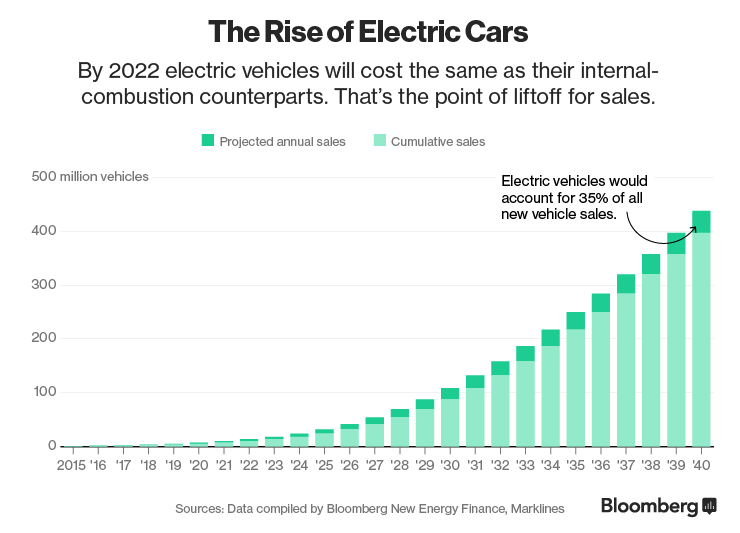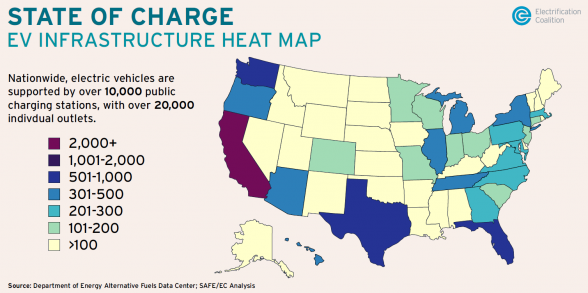Why We Need Smarter Infrastructure

Who will you meet?
Cities are innovating, companies are pivoting, and start-ups are growing. Like you, every urban practitioner has a remarkable story of insight and challenge from the past year.
Meet these peers and discuss the future of cities in the new Meeting of the Minds Executive Cohort Program. Replace boring virtual summits with facilitated, online, small-group discussions where you can make real connections with extraordinary, like-minded people.
Tesla just shook up the entire auto industry to the tune of 400,000+ Model 3 reservations. With every major automotive manufacturer gearing up a rival electric vehicle, EVs are about to hit the mainstream. While this is great news for Tesla EVs are currently heading for major trouble.
Too Many EVs, Not Enough Stations
EVs have grown a lot in the past 10 years. The price of batteries continues to drop dramatically, the range on a single charge has skyrocketed, and let’s not forget the outrageous acceleration and speed. There is almost too much to like about the coming wave of EVs, but is everything really pointing up?
For all the good Tesla, Nissan, BMW, and GM have done in the EV industry these past few years, they made a crippling oversight when it comes to EVs: powering them. After all what good is an electric vehicle without electricity. Right now the general assumption is EVs can just plug in anywhere, or cars can utilize a charging network. Unfortunately, these assumptions are dead wrong.
Charging an EV isn’t exactly like powering your MacBook. While you can plug them into a regular 110v outlet, typically referred to as Level 1 charging, it’s far from ideal. Currently, charging a Tesla this way takes around 100 hours. You read that right, 100 hours. Level 2 charging is a viable option but it still takes 10 hours to completely fill up. Not to mention many home and parking garages don’t have a 220v plug readily available meaning you’ll need to pay for one to be installed. Depending on where you live, and how far away your parking space is from the breaker, it might get expensive.
We are walking into a 1970s style fuel crisis. Except this time, it’s not the fuel that’s in short supply but the actual stations themselves.
If you’re thinking “No problem I can just utilize a public charging network” the problems only get worse. Right now in the US electric vehicles outnumber all public charging stations 15-to-1. Furthermore, most public chargers are Level 2, meaning you better bring a good book because you’re going to be there awhile. Even if every public station was a Level 3, commonly referred to as a supercharger station the 15 to 1 ratio still makes charging an extremely undesirable. Currently only 10% are Level 3 and those take around 45 minutes to an hour to get a full charge. All this is happening before we go ahead and dump another 400,000+ EVs on the road.

Tesla has put a good amount of the infrastructure burden on themselves, rigorously building out their own private supercharger network for their vehicle owners. The venture has been relatively successful (depending on which state you live in), but Tesla has started to feel the price of success. Most recently by sending out notices to drivers for “overusing” the supercharge network and gently reminding them its for long distance journeys, even going as far to remind them the optimal solution is to get in-home charging.
When we really break it all down, we simply don’t have the chargers needed to handle the demand and we are walking into a 1970s style fuel crisis. Except this time, it’s not the fuel that’s in short supply but the actual stations themselves. Building out the infrastructure needed is no small nor easy task and you only have to look at Tesla and see why.
Building The Future
Building in open areas close to the power source is fairly easy and while still not cheap it is the most cost-effective. The problem for the US, and the rest of the world is we continue to urbanize. Right now 86% of Americans live in urban areas and that makes things a lot more difficult. Why? Gaining additional access to power is no easy feat, couple that with the extremely high cost and you can see why charging stations aren’t everywhere.

The fact of the matter is most buildings, and cities for that matter were never designed for the large additional power drain that EVs cause. For older buildings asking them to install a handful of charging stations could be a multi-million dollar request, especially if they are of the supercharger variety.
This is why intelligent systems are key, ones that allow the install of additional infrastructure without the crippling costs that normally come with it. Most buildings only have a finite amount of power available for charging stations, and can only add a few stations. However, intelligent systems can maximize that existing infrastructure by directing power to go where and when it’s needed.Understanding a few basic points like which stations are in use, how much power is available, and drivers charging habits intelligent systems can get the most out of current building infrastructure. By doing this these systems can easily allow for ten times the amount of charging stations
The biggest hurdle of EVs is simply, “Who pays for the power?”. While electricity is cheaper than gasoline its still not free and those costs will add up. Despite what many hope, building owners aren’t exactly thrilled at the idea of eating this cost and intelligent systems solve this issue too through built in metering and billing.
With so many EVs coming, there isn’t much time to get started, but we do have a small window before they arrive. With such little time, we need to start building out the future of charging stations now before it’s too late.
Discussion
Leave your comment below, or reply to others.
Please note that this comment section is for thoughtful, on-topic discussions. Admin approval is required for all comments. Your comment may be edited if it contains grammatical errors. Low effort, self-promotional, or impolite comments will be deleted.
1 Comment
Submit a Comment
Read more from MeetingoftheMinds.org
Spotlighting innovations in urban sustainability and connected technology
Middle-Mile Networks: The Middleman of Internet Connectivity
The development of public, open-access middle mile infrastructure can expand internet networks closer to unserved and underserved communities while offering equal opportunity for ISPs to link cost effectively to last mile infrastructure. This strategy would connect more Americans to high-speed internet while also driving down prices by increasing competition among local ISPs.
In addition to potentially helping narrow the digital divide, middle mile infrastructure would also provide backup options for networks if one connection pathway fails, and it would help support regional economic development by connecting businesses.
Wildfire Risk Reduction: Connecting the Dots
One of the most visceral manifestations of the combined problems of urbanization and climate change are the enormous wildfires that engulf areas of the American West. Fire behavior itself is now changing. Over 120 years of well-intentioned fire suppression have created huge reserves of fuel which, when combined with warmer temperatures and drought-dried landscapes, create unstoppable fires that spread with extreme speed, jump fire-breaks, level entire towns, take lives and destroy hundreds of thousands of acres, even in landscapes that are conditioned to employ fire as part of their reproductive cycle.
ARISE-US recently held a very successful symposium, “Wildfire Risk Reduction – Connecting the Dots” for wildfire stakeholders – insurers, US Forest Service, engineers, fire awareness NGOs and others – to discuss the issues and their possible solutions. This article sets out some of the major points to emerge.
Innovating Our Way Out of Crisis
Whether deep freezes in Texas, wildfires in California, hurricanes along the Gulf Coast, or any other calamity, our innovations today will build the reliable, resilient, equitable, and prosperous grid tomorrow. Innovation, in short, combines the dream of what’s possible with the pragmatism of what’s practical. That’s the big-idea, hard-reality approach that helped transform Texas into the world’s energy powerhouse — from oil and gas to zero-emissions wind, sun, and, soon, geothermal.
It’s time to make the production and consumption of energy faster, smarter, cleaner, more resilient, and more efficient. Business leaders, political leaders, the energy sector, and savvy citizens have the power to put investment and practices in place that support a robust energy innovation ecosystem. So, saddle up.






Great article. Winter is coming… and nobody is preparing for it. When 2022 come’s around, those who have prepare, will capitalize on this new and emerging market.